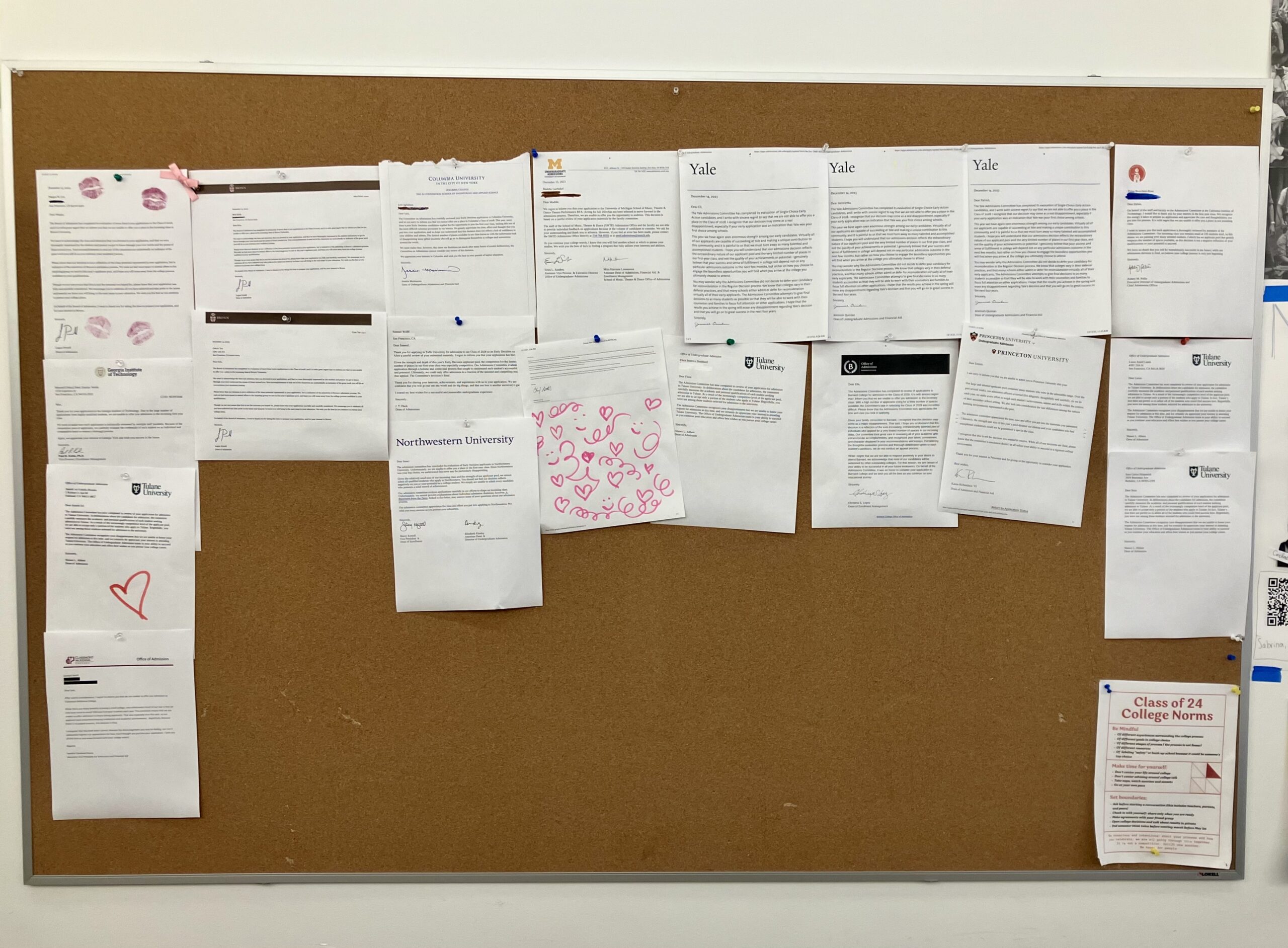On December 14, 2023, three Lick-Wilmerding High School seniors pinned up letters on the bulletin board of the third floor. Each letter contained the same sentiment: “We regret to inform you…”
Over the next few days, more letters populated the board, many facetiously adorned with colorful doodles and lipstick marks. Each was stamped with the seals of some of the most prestigious universities in the country like Yale, Brown and Princeton. As of spring 2024, around 20 letters decorate the board, and the evocative display has earned a name: The Wall of Rejection.
While the concept of a rejection wall is not a widespread practice across the country, there have been many reports of rejection walls in schools, most notably in California and Massachusetts. The concept originated at Palo Alto High School in 2004 and has remained an on-and-off tradition there ever since.
In the years since, a handful of high schools in the Bay Area, one of the most academically competitive regions in the country, have followed suit. These schools include Crystal Springs Upland School in Hillsborough and Gunn High School in Palo Alto. Additionally, several high schools in Massachusetts have reported rejection walls, such as Newton South High School and Wayland High School.
At LWHS, the rejection wall for the 2023-2024 college season was started by Henrietta Benziger ’24, Eli Rangarajan ’24 and Patrick Wu ’24, who all put up their rejection letters from Yale University on December 14, during the week when many colleges’ early decision letters were sent out. By the end of the next day, several other students had chosen to post their letters as well, and the flourishing rejection wall soon set the LWHS community abuzz.

photo courtesy of Henrietta Benziger
Kristen Cox ’24 first heard about the board in her English class. “During class at the end of the day, everyone was talking about [the rejection wall]…Soon, everyone was printing their rejection letters together and we went [to put them up]…It was fun, and I put [my letter] up and I doodled all over it. I just turned it into an art piece,” she said.
Chelsie Joy Valerio ’25 first heard about the rejection wall from seniors in her Private Skills for a Public Purpose (PSPP) class. “We found out from a senior that there was a rejection wall, and a bunch of us ran out to see it…I was pretty shocked by the things that I saw. I think as a junior, it’s nice to see these things because you don’t really know the reality of the college process yet,” she said. “At least for me, it was never about wanting to see who’s getting rejected, but seeing what schools people are applying to and the stats of who’s getting in helps me be realistic with what I want to do [next year].”
For many, the rejection wall has been an outlet to challenge the stigma surrounding rejection at an extremely high-achieving school such as LWHS. According to LWHS’s school profile, LWHS is the most selective independent high school in the Bay Area with 900 to 1000 applications received annually and less than 20% of applicants offered admission.
According to Rangarajan, this high-achieving and academically competitive culture often fosters a negative attitude towards rejection that the rejection wall was created to combat. “Most [LWHS students] have probably gotten into most things. For some that might still be true during the college process, but for most of us it won’t be. Especially for younger grades, just knowing that you will fail [is important],” he said.
However, many students have noted the fact that only extremely selective and prestigious schools have been represented on the wall, notably Ivy Leagues and schools with notoriously low acceptance rates. While some students view this as extracting power from big-name institutions, others view it as divisive because not all students possess the ability or resources to apply to those schools.
“I think it is both taking away their power but also giving them power…it’s like saying that these colleges are so selective they’re not taking even the brightest, smartest, most intelligent, kindest people I’ve ever met,” Cox said. “But I do think it makes them seem like they’re just a little label [instead of] these big, scary, life-controlling things. There’s something about being able to print out their little letter and doodle on it and stick it to a board that just makes it seem like, ‘Yeah, you are not bigger than me, you do not have power over me.’”
But the affluence of the schools on the board landed differently for Joshua Patterson ’24. “I don’t like the rejection wall because I feel like you’re just putting Ivy League schools up, like really top-notch schools, and some people didn’t even apply to those because they didn’t feel like they had a chance. To me, it feels a little bit like showing off,” he said.
Meanwhile, Cillian Stanley ’26 noted that the rejection wall may also set an impossible standard for underclassmen to apply to extremely competitive schools when going through the process themselves. “The reality of the situation is, some people will have no chance of getting into those universities,” he said. “Maybe it’s to no fault of their own, but if you make the assumption that the only colleges people are applying to are [ones with] five percent [acceptance rates], it definitely creates an expectation that you’re going to be applying to those, and some people might not be.”
This emphasis on the selectivity of schools and the pressure to apply to top-ranked colleges has heightened in the past few years, as acceptance rates amongst colleges with the most prestige and name recognition have plummeted. According to Business Student, acceptance rates at the top 50 schools fell from 35.9% in 2006 to 22.6% in 2018. This steady decline also saw a sudden drop during the pandemic, as applying to colleges became simpler with the introduction of virtual visits and test-optional policies that have, for the most part, extended beyond the lockdown period.
As a result, the number of colleges that students apply to on average has increased dramatically in recent years. According to the Common Application, college applications rose by 24% between the 2019-2020 and 2022-2023 academic year, while the average number of schools students applied to jumped by 8% between 2019 and 2020 in the largest growth year yet.

graph courtesy of Towards Data Science
While colleges’ standards for the applications they receive have largely remained stagnant, the notable increase in the number of applications to top-notch colleges has caused more and more rejection letters to be churned out each year. As of recent, a widespread effort to normalize rejection has emerged amongst high school students, with rejection walls being only one example. Other forms of celebrating rejection, including rejection parties in which students put their letters in a shredder or burn them in a bonfire, have been reported on by newspapers such as The New York Times and LA Times.
According to Benziger, this idea of celebrating rejection was the inspiration for creating the rejection wall. “For people who have been dreaming of going to a certain college, [rejection] can be very difficult to accept. A really good way to help them form that acceptance is by the final, physical act of putting up their letter on the wall and letting everyone see it,” she said. “Doing that and feeling like people around you aren’t going to judge you for it, and that your closing act is sharing that with your community, speaks to the kind of place we have at Lick and, hopefully, the culture we build around college.”
Rangarajan hopes that the rejection wall minimizes anxieties surrounding college applications. “If you spend your whole high school experience focusing on college, your whole early life is focused on college, and then college is all focused on graduate school. Be a little more present in the moment. There’s a sense of randomness to the process that’s nice to accept. Just live your life and try your best,” he said.
Though the future of the rejection wall remains unclear, its presence at LWHS has acted as a vessel for many students to combat their stigmas surrounding rejection and emphasize their worth beyond an institution. “[Rejection] feels less shameful now,” Cox said. “There’s a distance between me and the letter. It’s not this private burden that only I know about or only I’ve seen. It’s out there in the world, and it’s just a piece of paper…it doesn’t define me.”











NYucvPZbwo
Escort Gazette review guide with free verified ads in Europe. Best Escort Girls, Strip clubs, Brothels, Massage parlors on the map. Easy search directory. https://coletten803pbl7.bloggerbags.com/profile
Escort Gazette review guide with free verified ads in Europe. Best Escort Girls, Strip clubs, Brothels, Massage parlors on the map. Easy search directory. https://peakbookmarks.com/story16999941/best-escort-girls-strip-clubs-brothels-massage-parlors-on-the-map-easy-search-directory
Escort Gazette review guide with free verified ads in Europe. Best Escort Girls, Strip clubs, Brothels, Massage parlors on the map. Easy search directory. https://dominickwjwi68124.loginblogin.com/32543048/best-escort-girls-strip-clubs-brothels-massage-parlors-on-the-map-easy-search-directory
Escort Gazette review guide with free verified ads in Europe. Best Escort Girls, Strip clubs, Brothels, Massage parlors on the map. Easy search directory. https://7bookmarks.com/story16859562/best-escort-girls-strip-clubs-brothels-massage-parlors-on-the-map-easy-search-directory
Escort Gazette review guide with free verified ads in Europe. Best Escort Girls, Strip clubs, Brothels, Massage parlors on the map. Easy search directory. https://heliskidirectory.com/listings12691659/escort-gazette-review-guide-with-free-verified-ads-in-europe
Escort Gazette review guide with free verified ads in Europe. Best Escort Girls, Strip clubs, Brothels, Massage parlors on the map. Easy search directory. https://base-directory.com/listings12682292/escort-gazette-review-guide-with-free-verified-ads-in-europe
Escort Gazette review guide with free verified ads in Europe. Best Escort Girls, Strip clubs, Brothels, Massage parlors on the map. Easy search directory. https://begindirectory.com/listings12690737/best-escort-girls-strip-clubs-brothels-massage-parlors-on-the-map-easy-search-directory
Escort Gazette review guide with free verified ads in Europe. Best Escort Girls, Strip clubs, Brothels, Massage parlors on the map. Easy search directory. https://johnw257fse4.angelinsblog.com/profile
Escort Gazette review guide with free verified ads in Europe. Best Escort Girls, Strip clubs, Brothels, Massage parlors on the map. Easy search directory. https://active-bookmarks.com/story16878774/best-escort-girls-strip-clubs-brothels-massage-parlors-on-the-map-easy-search-directory
Escort Gazette review guide with free verified ads in Europe. Best Escort Girls, Strip clubs, Brothels, Massage parlors on the map. Easy search directory. https://angelovjwi69147.wikigiogio.com/629917/escort_gazette_review_guide_with_free_verified_ads_in_europe
Escort Gazette review guide with free verified ads in Europe. Best Escort Girls, Strip clubs, Brothels, Massage parlors on the map. Easy search directory. https://remingtonxlyk79247.ampblogs.com/best-escort-girls-strip-clubs-brothels-massage-parlors-on-the-map-easy-search-directory-63067270
Escort Gazette review guide with free verified ads in Europe. Best Escort Girls, Strip clubs, Brothels, Massage parlors on the map. Easy search directory. https://dantewkxj69124.is-blog.com/32497984/best-escort-girls-strip-clubs-brothels-massage-parlors-on-the-map-easy-search-directory
Escort Gazette review guide with free verified ads in Europe. Best Escort Girls, Strip clubs, Brothels, Massage parlors on the map. Easy search directory. https://lukasaoaj69146.getblogs.net/58598973/best-escort-girls-strip-clubs-brothels-massage-parlors-on-the-map-easy-search-directory
Escort Gazette review guide with free verified ads in Europe. Best Escort Girls, Strip clubs, Brothels, Massage parlors on the map. Easy search directory. https://followbookmarks.com/story17049959/best-escort-girls-strip-clubs-brothels-massage-parlors-on-the-map-easy-search-directory
PKibYNkVORBdaExy
FEXpuwIl
oNAcxRbTt
LkVonXWbgK
vhNaeopDfQqWGtE
DtzLQXqBga